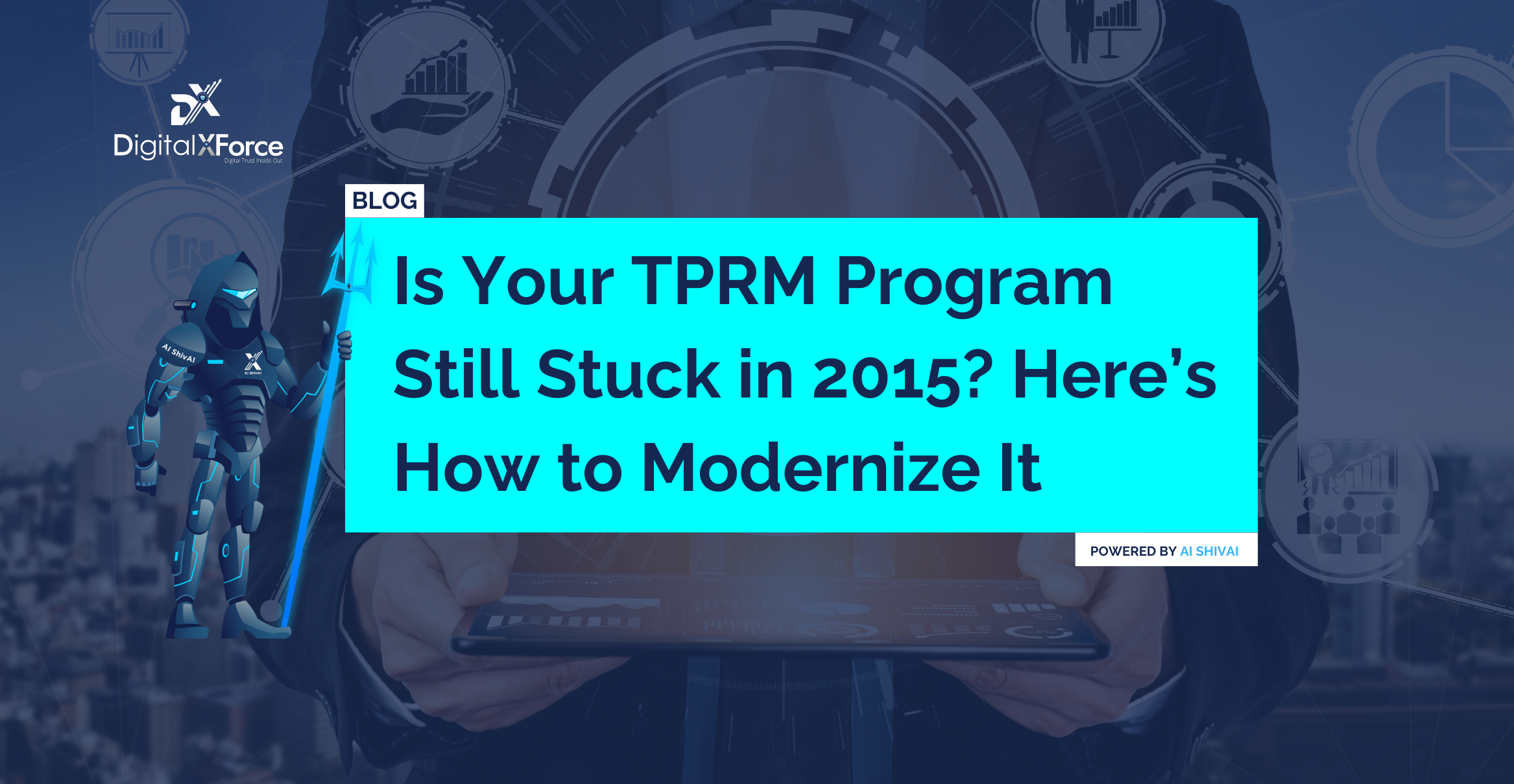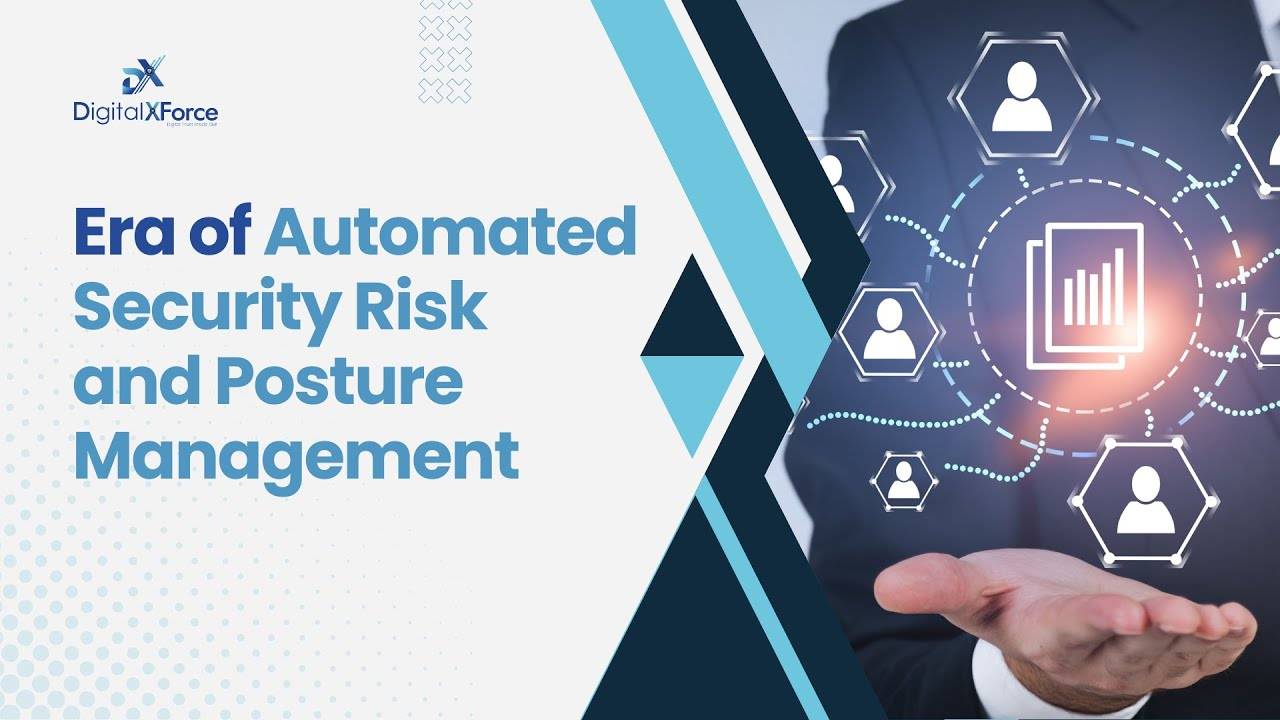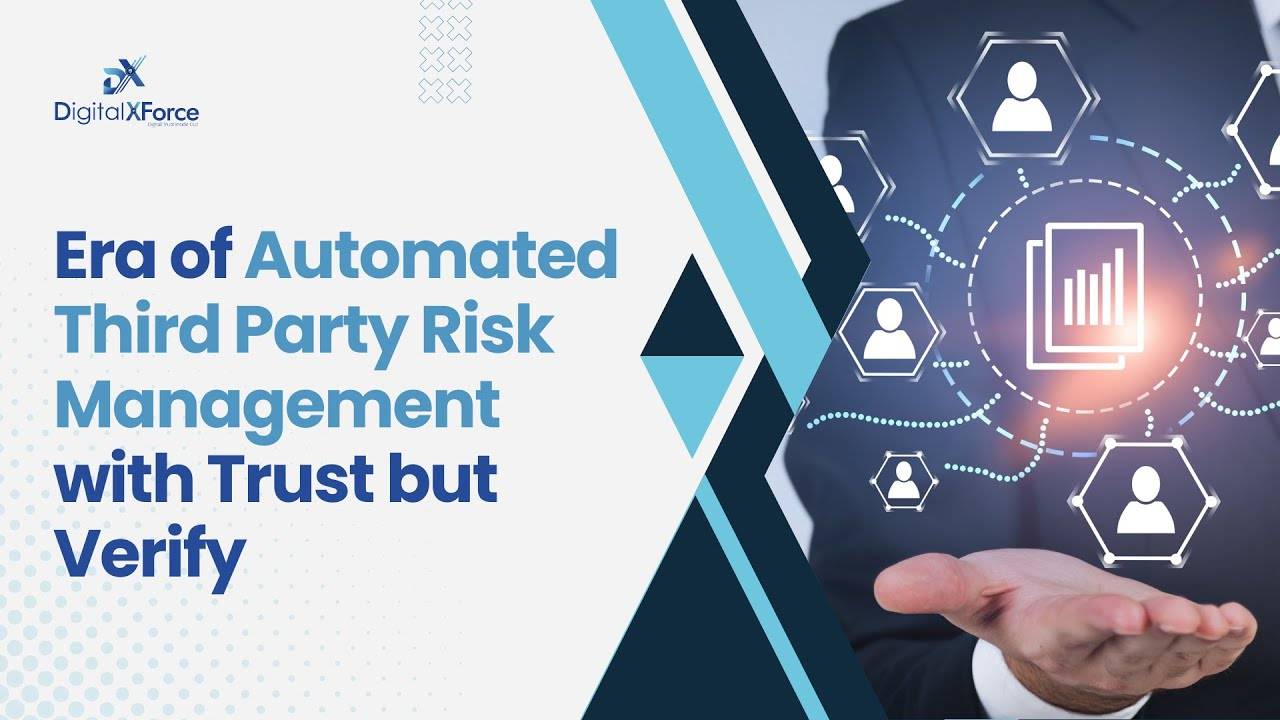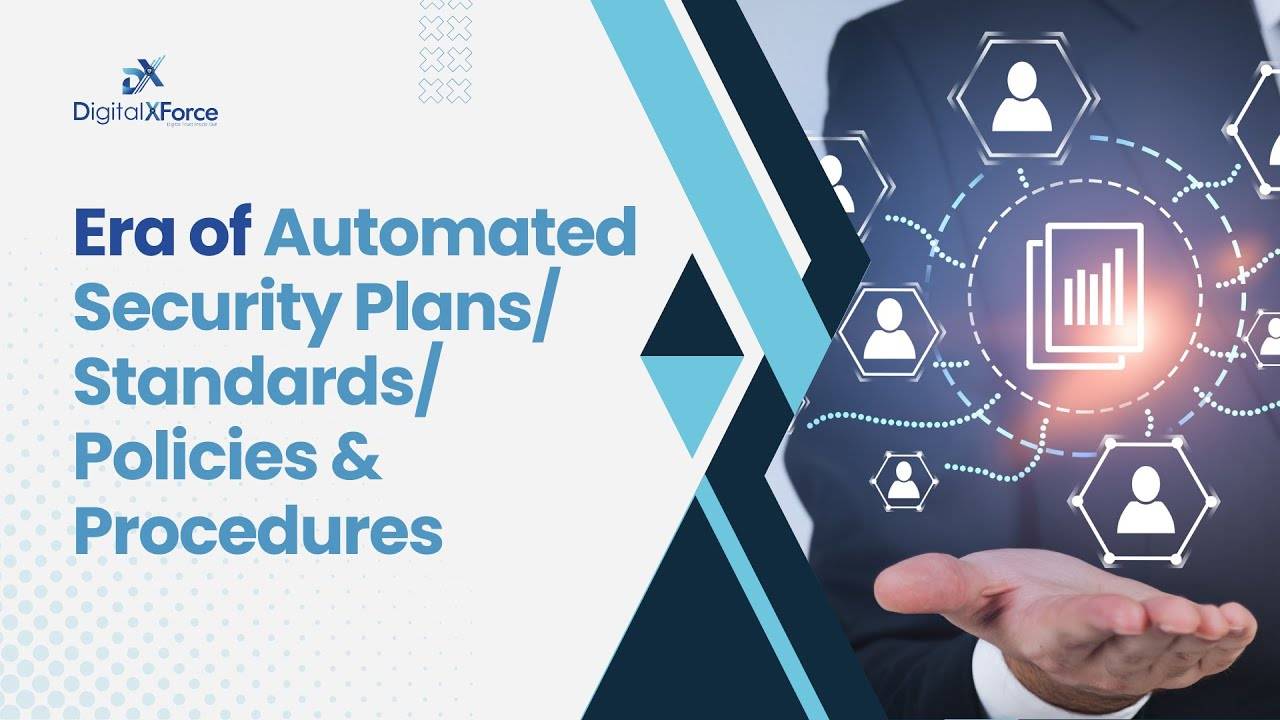
In 2015, third-party risk management (TPRM) was largely a checkbox function. Organizations collected vendor questionnaires once a year, reviewed PDF policies manually, and assumed that spreadsheet-based oversight was “good enough.”
But in 2025, that approach is dangerously outdated.
The attack surface has exploded. Regulators demand real-time assurance. Customers expect digital trust. And cybercriminals are increasingly targeting vendors and partners as weak links — from cloud providers and billing platforms to SaaS apps and IoT integrators.
The truth? If your TPRM program hasn’t evolved, it’s a liability.
That’s why leading enterprises are modernizing their third-party risk management strategies with platforms like DigitalXForce, which replaces outdated, manual, and periodic processes with AI-powered, automated, real-time TPRM aligned to enterprise risk and business outcomes.
Is your TPRM Program still stuck in 2015? Let’s unpack what’s changed — and what modern TPRM looks like today.
The 2015 TPRM Playbook: Why It No Longer Works
Five or ten years ago, a typical third-party risk program looked like this:
- Annual or biannual security questionnaires
- Manual risk reviews (mostly qualitative)
- Siloed GRC systems
- Spreadsheets to track status and follow-up
- Point-in-time vendor assessments with little follow-up
- A “set it and forget it” mentality
Back then, it worked — or at least seemed to.
But today’s ecosystem is more complex and volatile than ever:
Overall Third-Party Breach Statistics
- Prevalence: Third-party breaches continue to be a significant and growing problem. Verizon 2025 DBIR reports that nearly 30% of data breaches in 2025 involved a third-party supplier, which is double the percentage from the previous year. A Whistic 2025 TPRM report indicates that over the past three years, 77% of all security breaches originated with a vendor or other third party.
- Cost: The financial impact of third-party breaches is substantial. When a breach originates from a third-party system, the average cost to remediate it is nearly $4.8 million, which is higher than the cost of a breach caused by internal systems alone. The average total cost of a data breach in the United States is the highest globally at $9.36 million, with the Middle East following closely at $8.75 million.
- Growing Vendor Ecosystems: Organizations are working with more vendors than ever before. In 2025, the average number of vendors a company works with has increased to 286, a 21% increase year-over-year. This rapid expansion of vendor ecosystems creates a larger attack surface.
TPRM Challenges and Trends in 2025
- Assessment Gap: Despite the growing risks, many organizations are struggling to keep up. One survey found that only 4% of organizations have high confidence that their third-party risk questionnaires accurately reflect the reality of the third party’s security posture.
- Ineffective Methodologies: A large percentage of companies, 94%, report that they lack the time or resources to assess all their vendors thoroughly. This is a major reason why traditional, manual, and questionnaire-based approaches are proving ineffective.
- Shift to Automation and AI: To address this gap, there is a clear trend toward leveraging technology. Over 60% of organizations are using some level of security AI and automation, and a significant percentage are exploring AI for due diligence, risk classification, and contract review.
- Continuous Monitoring: Organizations are moving away from one-time or annual assessments and are shifting towards continuous, real-time monitoring of their third-party ecosystems. This helps in the timely detection of malicious activity and provides a more dynamic risk rating.
- Regulatory Scrutiny: Regulatory pressure is increasing globally. By 2025, 60% of organizations will be required to manage third-party relationships under regulatory scrutiny. This is driving investments in automated tools that facilitate compliance reporting.
- Global supply chains now include thousands of interconnected vendors.
- Cloud-native architectures blur the lines between internal and external systems.
- Regulators (e.g., DORA, SEC, NYDFS) require evidence of active vendor oversight.
- Cyber insurance providers demand proof of third-party resilience.
Key Third-Party Breaches in 2025
- Qantas: A breach in June 2025 detected suspicious activity in a third-party platform used by one of its offshore call centers. Hackers accessed up to 6 million customer records.
- Episource Healthcare Billing: A U.S. medical billing firm detected unauthorized network access, and the breach, publicly disclosed in June, affected over 5.4 million individuals.
- USB / Chain IQ Group AG: A breach via a third party exposed over 130,000 employee records, including sensitive personal and contact information from major firms.
In short, TPRM cannot be a once-a-year project anymore.
The stakes are higher. The tools must be smarter.
What “Modern TPRM” Looks Like in 2025
Forward-looking organizations are replacing traditional GRC-based TPRM with integrated, intelligent, and automated platforms that provide:
| Legacy TPRM (2015) | Modern TPRM (2025) |
| Manual questionnaires | Automated evidence ingestion |
| Point-in-time assessments | Continuous Assessments |
| Siloed Risk collation | Unified, enterprise-wide risk view continuosly and real time, AI based automated analysis of audit reports (SOC 2, etc.) |
| Qualitative scores (not translated to revenue impact) | Risk quantified in dollars, Intangible parameters like impact on reputation quantified |
| Static controls frameworks | Dynamic mappings across NIST, ISO, etc. |
| Reactive issue tracking | Predictive AI-driven risk forecasting |
DigitalXForce is leading this shift with a real-time TPRM module that integrates seamlessly into its broader Enterprise Security Risk and Posture Management platform.
Introducing DigitalXForce TPRM: Built for Real-Time, AI-Driven Risk
DigitalXForce is more than just a compliance platform — it’s a risk intelligence engine.
When it comes to TPRM, DigitalXForce delivers capabilities that go far beyond legacy GRC tools or traditional vendor risk systems.
Here’s what sets it apart:
1. AI-Powered Vendor Risk Scoring
Legacy vendor scoring relied on subjective reviews and yes/no questions.
DigitalXForce uses its proprietary AI engine ShivAI to dynamically analyze:
- Vendor control evidence (uploaded or integrated ingesting telemetry automatically and real time)
- Public threat intelligence feeds
- Historical breach and incident data
- Geo-political and regulatory exposure
- Behavioral patterns across the vendor ecosystem has led to dynamic and adaptive risk scoring, with a view of performance with respect to peers. Several Clients are immensely benefitting from this
This allows DigitalXForce to assign real-time, contextual risk scores across:
- Operational risk
- Cybersecurity posture
- Regulatory exposure
- Financial health
- Geographic risk factors
- Brand reputation and associated risk
Result: Vendor risk is no longer just “high/medium/low” — it’s quantifiable, comparable, and actionable.
2. Continuous Controls Monitoring (CCM) for Third Parties
With breaches like SolarWinds and MOVEit showing how fast vendors can be weaponized, real-time visibility is a must. The most recent was Crowdstrike which clearly indicated inadequate testing before patch deployment.
DigitalXForce’s CCM engine continuously evaluates a third party’s:
- IAM Posture
- Control compliance (e.g., MFA, encryption, patching)
- Vendor’s security processes and evaluating on a near real time basis the compliance to contractually agreed Security SLAs.
Organizations can configure policy-based triggers such as:
- “Alert if control PR.AC-1 (access control) degrades below 80%”
- “Block vendor access if unresolved issues > 30 days”
- “Escalate vendors with open findings during incident response”
Result: Vendors are no longer blind spots — they become managed extensions of your enterprise security fabric with a strong accountability and focus on managing Security
3. Automated Evidence Collection and Framework Mapping
Instead of chasing vendors for questionnaires and PDFs, DigitalXForce automates evidence ingestion via:
- Direct integrations (API based) with vendor platforms (e.g., AWS, Okta, Azure, Qualys, Z Scaler, Trellix)
- Secure vendor portals for document uploads
- AI-powered analysis and parsing of certifications, audit reports, and SOC 2s eventually translating into overall Risk scores and potential revenue impact if the Risks are not addressed
- Cross-mapping to frameworks like NIST CSF, ISO 27001, DORA, and more (Cusotmized frameworks can be added and any specific new framework can be configured in no time)
Each piece of evidence is automatically tagged, versioned, and linked to relevant controls.
Result: Continuous Security Posture Management has zero business interruption — it becomes a Culture.
4. Zero Trust-Ready Access Governance
Many TPRM programs overlook one of the biggest risks: excessive or unmanaged access.
DigitalXForce provides real-time visibility into:
- Which vendors have access to what systems
- What data flows between your environment and theirs
- Whether least privilege and Zero Trust principles are enforced
Combined with dynamic identity risk scoring, DigitalXForce enables automated offboarding, just-in-time access, and risk-triggered revocations.
Result: Access is no longer a static list — it’s a live, governed perimeter.
5. Business-Aligned KPIs, KRIs, and Reporting
Boards don’t want to hear about “Questionnaire Stage 2” or “SOC 2 renewals.” They want to know:
- Which critical vendors pose the most risk to operations?
- Are third-party risks increasing or decreasing?
- What’s the potential financial impact of a vendor breach?
DigitalXForce delivers customizable dashboards and narratives that translate TPRM metrics into business language, including:
- KRIs: % of vendors with unresolved critical risks
- KPIs: Time to risk resolution, SLA adherence, remediation effectiveness
- Risk quantification: Exposure by vendor category, control family, or business unit
Result: TPRM becomes part of strategic decision-making, not buried in the GRC back office.
A Day in the Life: TPRM with DigitalXForce vs. Legacy GRC
| Task | Legacy TPRM | DigitalXForce |
| Vendor Onboarding | Manual intake forms, 2-3 weeks (after the contract is signed with the perspective vendor) | Automated risk scoring, onboarding in 1-2 days |
| Risk Assessments | Annual questionnaires | Continuous risk scoring + CCM |
| Evidence Review | Manual PDF reviews | AI-powered ingestion + mapping |
| Reporting | Spreadsheet exports | Real-time dashboards, executive reports |
| Remediation Tracking | Shared inbox, Excel logs | Auto-ticket creation + SLA tracking |
| Board Updates | Reactive, qualitative | Predictive, quantifiable, business-aligned |
- Improved productivity due to reduced efforts? Up to 80% reduction in assessment overhead on an average and can be much more contextual to the Organization sector and size.
- Risk reduction? Up to 90%+ faster detection and remediation of vendor control failures.
- Assurance? End-to-end audit trails, real-time proof of oversight.
Final Thought: Don’t Just Modernize — Future-Proof
In a world where digital ecosystems are constantly evolving, your TPRM program must be adaptive, intelligent, and aligned with business outcomes.
That’s what DigitalXForce enables.
It’s not just an upgrade from GRC — it’s a new category:
AI powered, continuous and real time Enterprise Security Risk and Posture Management — with TPRM at the core.
Ready to Leave 2015 Behind?
- Improved Security Assurance
- Positive Balance sheets
- Future Ready leveraging the power of our AI-enabled platform
It’s time to experience DigitalXForce!
👉 Request a Demo Today and discover how our AI-powered TPRM can modernize your program, reduce risk, and build the trust your business needs to grow.
About DigitalXForce
DigitalXForce is the AI-driven Enterprise Security Risk and Posture Management platform that unifies cyber risk, compliance, and digital trust into a single intelligent system. With built-in TPRM, CCM, and risk quantification, DigitalXForce helps organizations go beyond compliance and build a security posture that’s ready for what’s next.



